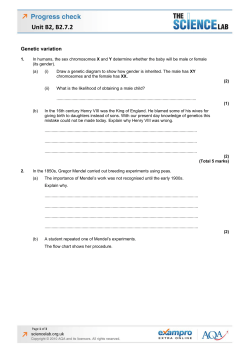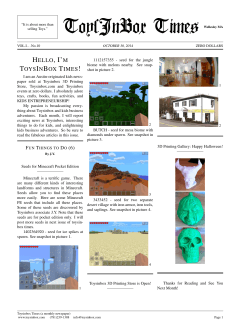
Proposed Maximum Residue Limit PMRL2015-08
Proposed Maximum Residue Limit PMRL2015-08 Propiconazole 19 March 2015 (publié aussi en français) This document is published by the Health Canada Pest Management Regulatory Agency. For further information, please contact: Publications Pest Management Regulatory Agency Health Canada 2720 Riverside Drive A.L. 6607-D Ottawa, Ontario K1A 0K9 Internet: pmra.publications@hc-sc.gc.ca healthcanada.gc.ca/pmra Facsimile: 613-736-3758 Information Service: 1-800-267-6315 or 613-736-3799 pmra.infoserv@hc-sc.gc.ca ISSN: 1925-0835 (print) 1925-0843 (online) Catalogue number: H113-24/2015-8E (print version) H113-24/2015-8E-PDF (PDF version) © Her Majesty the Queen in Right of Canada, represented by the Minister of Health Canada, 2015 All rights reserved. No part of this information (publication or product) may be reproduced or transmitted in any form or by any means, electronic, mechanical, photocopying, recording or otherwise, or stored in a retrieval system, without prior written permission of the Minister of Public Works and Government Services Canada, Ottawa, Ontario K1A 0S5. Under the authority of the Pest Control Products Act, Health Canada’s Pest Management Regulatory Agency (PMRA) has received applications to register technical grade benzovindiflupyr and the end-use product A18993 Fungicide, a co-formulation with technical grade propiconazole, for use in Canada on various commodities, including those in CSG 20A. The evaluation of this propiconazole application indicated that the end-use product has merit and value and the human health and environmental risks associated with the new uses are acceptable. Before registering a pesticide for food use in Canada, the PMRA must determine the quantity of residues that are likely to remain in or on the food when the pesticide is used according to label directions and that such residues will not be a concern to human health. This quantity is then legally established as a maximum residue limit (MRL). An MRL applies to the identified raw agricultural food commodity as well as to any processed food product that contains it, except where separate MRLs are specified for the raw agricultural commodity and a processed product made from it. Consultation on the proposed MRLs for propiconazole is being conducted via this document (see Next Steps, the last section of this document). A summary of the field trial data used to support the proposed MRLs can be found in Appendix I. MRL consultation for the other active ingredient, benzovindiflupyr, present in A18993 Fungicide is being conducted under a separate action. To comply with Canada’s international trade obligations, consultation on the proposed MRLs is also being conducted internationally by notifying the World Trade Organization, as coordinated by Canada’s Notification Authority and Enquiry Point. The proposed MRLs, to be added to the MRLs already established for propiconazole, are as follows. Table 1 Proposed Maximum Residue Limits for Propiconazole Common Name Propiconazole 1 Residue Definition 1-[[2-(2,4-dichlorophenyl)-4-propyl-1,3dioxolan-2-yl]methyl]-1H-1,2,4-triazole MRL (ppm)1 0.02 Food Commodity Borage seeds, cuphea seeds, echium seeds, flaxseeds, gold of pleasure seeds, hare’s eat mustard seeds, milkweed seeds, mustard seeds (oilseed type), oil radish seeds, poppy seeds, sesame seeds, sweet rocket seeds ppm = parts per million MRLs established in Canada may be found using the Maximum Residue Limit Database on the Maximum Residue Limits for Pesticides webpage. The database allows users to search for established MRLs, regulated under the Pest Control Products Act, both for pesticides or for food commodities. Proposed Maximum Residue Limit - PMRL2015-08 Page 1 International Situation and Trade Implications MRLs may vary from one country to another for a number of reasons, including differences in pesticide use patterns and the locations of the field crop trials used to generate residue chemistry data. Table 2 compares the MRLs proposed for propiconazole in Canada with corresponding American tolerances and Codex MRLs. 1 American tolerances are listed in the Electronic Code of Federal Regulations, 40 CFR Part 180, by pesticide. A listing of established Codex MRLs is available on the Codex Alimentarius Pesticide Residues in Food website, by pesticide or commodity. Table 2 Comparison of Canadian MRLs, American Tolerances and Codex MRLs (where different) Food Commodity Canadian MRL (ppm)1 American Tolerance 0.02 0.30 (Rapeseed Subgroup 20A) (ppm) 1 Codex MRL (ppm)1 Borage seeds Cuphea seeds Echium seeds Flaxseeds Gold of pleasure seeds Hare’s ear mustard seeds Milkweed seeds None established Mustard seeds (oilseed type) Oil radish seeds Poppy seeds Sesame seeds Sweet rocket seeds 1 1 ppm = parts per million The Codex Alimentarius Commission is an international organization under the auspices of the United Nations that develops international food standards, including MRLs. Proposed Maximum Residue Limit - PMRL2015-08 Page 2 Next Steps The PMRA invites the public to submit written comments on the proposed MRLs for propiconazole up to 75 days from the date of publication of this document. Please forward your comments to Publications (see the contact information on the cover page of this document). The PMRA will consider all comments received before making a final decision on the proposed MRLs. Comments received will be addressed in a separate document linked to this PMRL. The established MRLs will be legally in effect as of the date that they are entered into the Maximum Residue Limit Database. Proposed Maximum Residue Limit - PMRL2015-08 Page 3 Proposed Maximum Residue Limit - PMRL2015-08 Page 4 Appendix I Appendix I Summary of Field Trial Data Used to Support the Proposed Maximum residue Limits Residue data from field trials conducted in Canada were previously submitted and reviewed to support the domestic use of QUILT Fungicide on rapeseeds (canola). Propiconazole was applied to rapeseed (canola) at label rates, and harvested according to label directions. In addition, a processing study in treated canola was previously submitted and reviewed to determine the potential for concentration of residues of propiconazole into processed commodities. Maximum Residue Limit(s) The recommendation for MRLs for propiconazole in borage seeds, cuphea seeds, echium seeds, flaxseeds, gold of pleasure seeds, hare’s eat mustard seeds, milkweed seeds, mustard seeds (oilseed type), oil radish seeds, poppy seeds, sesame seeds and sweet rocket seeds were extended from the MRL for propiconazole on rapeseeds (canola), the representative commodity for the rapeseeds crop subgroup (CSG 20A Revised). Table A1 summarizes the residue data used to calculate the MRL previously proposed for rapeseeds (canola). Table A1 1 2 Summary of Field Trial and Processing Data Used to Support MRLs Commodity Application Method/ Total Application Rate (g a.i./ha)1 Preharvest Interval (days) Minimum Residues (ppm) Maximum Residues (ppm) Experimental Processing Factor Rapeseeds (canola) Foliar2/117.7-138.1 29-30 <0.01 0.014 <0.16× (refined oil) g a.i./ha = grams of active ingredient per hectare Includes both ultra-low and high spray volume applications. No significant increase to propiconazole is anticipated to the dietary burden of livestock. Following the review of all available data, MRLs as proposed in Table 1 are recommended to cover residues of propiconazole. Residues of propiconazole in these crops at the proposed MRLs will not pose an unacceptable risk to any segment of the population, including infants, children, adults and seniors. Proposed Maximum Residue Limit - PMRL2015-08 Page 5
© Copyright 2025









